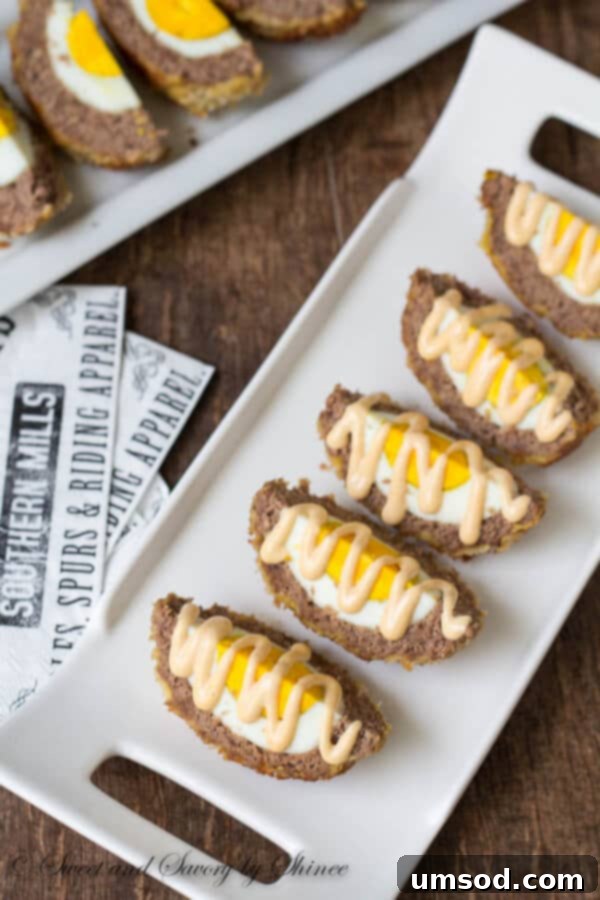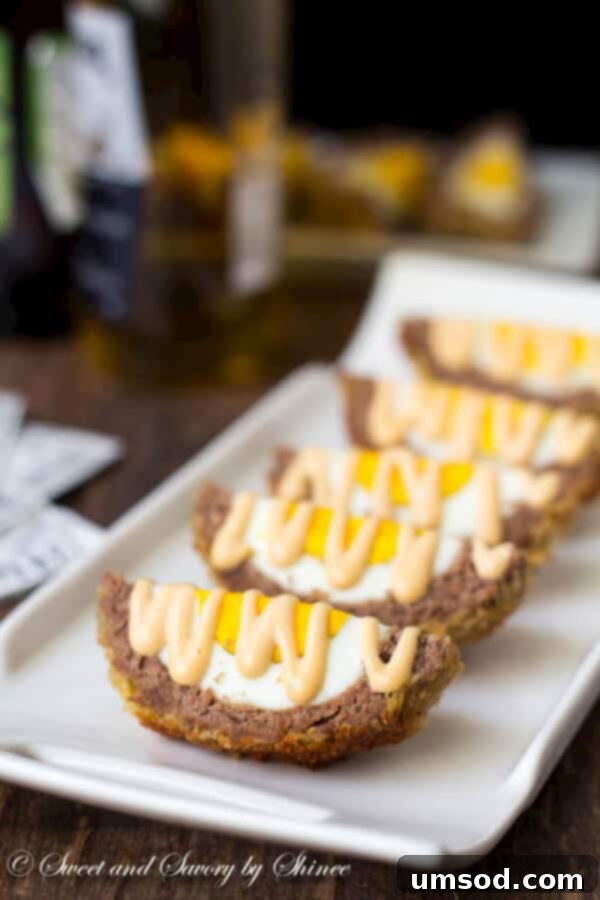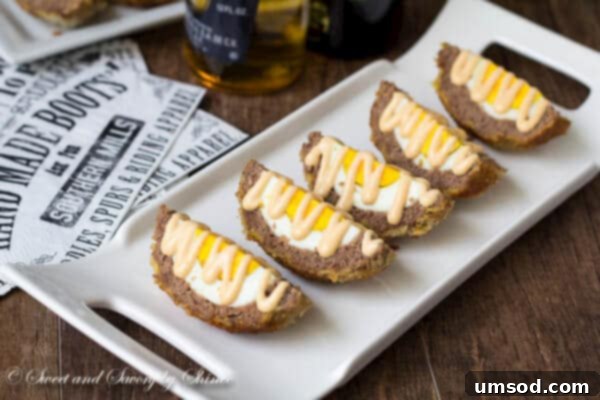
The Ultimate Baked Scotch Egg Recipe: Crispy, Savory & Perfect for Any Occasion
Get ready to impress your guests and satisfy your cravings with this incredible baked Scotch egg recipe! Whether you’re hosting a lively game day gathering, planning a cozy weekend meal, or simply seeking a unique and satisfying snack, these savory delights are guaranteed to be the star of your table. Forget the usual fuss and mess of deep-frying; our innovative baking method ensures a wonderfully crispy exterior and a perfectly cooked interior, every single time. Prepare to keep this simple yet show-stopping recipe close at hand, because after just one bite, everyone will undoubtedly be asking for your secret.

A Culinary Journey: The History and Enduring Appeal of Scotch Eggs
Happy Friday, culinary enthusiasts! As the weekend beckons, perhaps you’re brainstorming some exciting new dishes to try. If a Sunday game gathering, a casual family brunch, or simply a desire for something extraordinary is on your agenda, I have an exceptional recipe that promises to elevate your culinary repertoire. You might already be familiar with these delightful creations: perfectly boiled eggs, lovingly enveloped in a seasoned minced meat mixture, then coated in breadcrumbs and baked to golden perfection. These are, of course, Scotch eggs, a beloved and iconic pub snack often associated with the culinary traditions of England.

While Scotch eggs are commonly believed to be a British invention, with their origins often traced back to the esteemed London department store Fortnum & Mason in the 18th century, the fundamental concept of a meat-wrapped egg boasts a rich history across various global cuisines. My personal introduction to this culinary marvel occurred nearly a decade ago, during my student years in Mongolia. Back then, Scotch eggs were a surprisingly popular menu item, offering a unique and irresistible blend of textures and flavors that immediately captivated my palate. After relocating to the U.S., these delicious spheres, regrettably, faded from my immediate memory. However, a few years ago, a delightful rediscovery through social media sparked a wave of nostalgia. The vivid memories of their savory goodness returned, and I knew instantly that it was time to recreate this impressive dish in my own kitchen, infusing a classic with my unique touch.
Why These Baked Scotch Eggs Will Be Your New Favorite Go-To Recipe
Every single time I serve these homemade Scotch eggs, the reaction is consistently one of sheer awe and genuine delight. They possess an uncanny ability to impress my guests, drawing an chorus of “ohs” and “ahs” with their unique, rustic presentation and undeniably incredible taste. What truly sets them apart is their remarkable versatility. I’ve successfully served them both as a hearty and satisfying dinner entrée, perfectly paired with a crisp green salad or a medley of roasted seasonal vegetables, and equally effectively as a sophisticated and intriguing appetizer at various gatherings and parties. Regardless of the occasion, they consistently disappear at an astonishing rate, leaving everyone craving just one more bite. The harmonious combination of a remarkably crispy Panko coating, a layer of perfectly seasoned and succulent meat, and a creamy, beautifully cooked egg center is simply a symphony of flavors and textures that is truly irresistible.

Mastering the Art of Baked Scotch Eggs: Expert Tips for Success
Traditionally, Scotch eggs achieve their signature golden, crunchy exterior through deep-frying. However, for many home cooks, myself included, deep-frying can be a messy, time-consuming, and somewhat intimidating process that we often prefer to avoid. My brilliant solution? A perfected baking method that consistently yields equally delicious, wonderfully crispy results without any of the deep-frying hassle. I begin by expertly browning the breaded Scotch eggs on high heat in a skillet, a crucial step that not only locks in an incredible depth of flavor but also initiates the formation of that desirable crispy crust. Following this, they are transferred to the oven to finish cooking. This ingenious two-step approach guarantees that the eggs are thoroughly cooked through, boasting a beautifully golden and intensely crispy coating, and a tender, juicy, and flavorful meat layer within. It’s a game-changer for homemade Scotch eggs.
The Secret to a Perfectly Sealed Meat Wrap
One of the most common, yet easily avoidable, challenges when crafting Scotch eggs is preventing the seasoned meat mixture from falling apart during the cooking process. This crucial shaping step, though often overlooked, makes an immense difference in the final product’s integrity and appearance. Here’s my fool-proof, expert tip to master this and avoid any separation: after you’ve carefully encased the hard-boiled egg within the seasoned meat mixture, gently but firmly roll the entire “meatball” between your palms. Apply consistent, even pressure, effectively squeezing out any potential air pockets that might be trapped between the egg’s surface and the surrounding meat. This methodical action also serves to firmly seal all the edges of the meat, creating a cohesive, compact, and perfectly spherical form that will gracefully maintain its shape throughout the entire cooking process. Do not rush this vital step; dedicate a minute or so for each egg to ensure an impeccably tight and even seal, promising a flawless Scotch egg every time.
Achieving the Ultimate Crispy Coating (Without Deep Frying!)
Our superior baked method hinges on two critical phases to deliver that coveted truly crispy finish, rivaling any deep-fried version. First, the initial browning step in a hot skillet, utilizing just a touch of olive oil, is paramount. This creates an immediate, fantastic golden-brown crust and effectively helps to set the Panko breading firmly in place. It’s essential to ensure your skillet is adequately heated before carefully adding the eggs. Brown them quickly on all sides – typically about one minute per side – to prevent them from soaking up excessive oil while developing that initial, irresistible crunch. The second phase involves transferring the partially browned eggs to the oven for baking. This allows the meat to cook through uniformly and gently, while the Panko breading continues its journey to ultimate crispiness without the need for additional, heavy oil. This ingenious method not only simplifies cleanup dramatically but also results in a lighter, healthier Scotch egg that uncompromisingly delivers on both texture and profound flavor.
Foolproof Hard-Boiled Eggs Every Time: The Heart of a Perfect Scotch Egg
Let’s take a focused moment to discuss the very heart and soul of every magnificent Scotch egg: the hard-boiled egg. The precision in cooking and the ultimate doneness of your egg can profoundly impact the overall texture, flavor, and enjoyment of this exquisite dish. While our primary recipe calls for classic hard-boiled eggs, it’s worth noting that you possess a delightful degree of flexibility, allowing you to tailor the egg’s doneness precisely to your serving intentions and personal preferences.
Choosing the Right Egg Doneness for Your Dish
If your culinary vision for these delectable Scotch eggs leans towards serving them as a more substantial dinner entrée, you might thoughtfully consider utilizing soft-to-medium boiled eggs. A yolk that is slightly jammy, beautifully gooey, or exquisitely creamy can introduce an additional layer of unparalleled richness and a truly luxurious texture. This softer yolk elegantly complements the robust, savory meat and the satisfyingly crispy coating, creating a harmonious culinary experience. However, for a more practical and equally delightful appetizer version—particularly ideal for bustling parties, vibrant game day gatherings, or elegant picnics where guests might be enjoying them on the go—I unequivocally find that truly hard-boiled eggs are the superior choice. Their firm structure ensures less mess, makes them incredibly easy to handle, and allows them to maintain their perfect form and integrity, whether served whole or gracefully sliced, making them a fuss-free option for any social event.
My Simple Method for Perfectly Peeled Eggs (Say Goodbye to the Grey Ring!)
No one desires rubbery egg whites or that unsightly, unappetizing greenish-grey ring that sometimes appears around the yolk of an overcooked egg. This common discoloration is, more often than not, a clear indication of overcooking or improper cooling. Here’s my consistently fool-proof method for achieving perfectly cooked, vibrantly yellow-yolked, and incredibly easy-to-peel hard-boiled eggs:
- Carefully place your eggs in a single layer at the bottom of a saucepan.
- Add cold tap water to fully cover the eggs by approximately one inch.
- Stir in 1 teaspoon of salt. This small addition is widely believed to aid in the peeling process.
- Bring the water to a vigorous, rolling boil over high heat.
- As soon as the water reaches a full rolling boil, immediately reduce the heat to its lowest setting, cover the saucepan tightly with a lid, and let the eggs simmer gently for precisely 10 minutes for perfectly hard-boiled eggs.
- The moment the timer signals the end of the cooking period, swiftly drain the hot water from the saucepan. Immediately transfer the cooked eggs to a large bowl abundantly filled with ice-cold water. Allow them to cool completely in this ice bath, changing the cold water a couple of times if necessary, as rapidly stopping the cooking process is crucial.
- Once thoroughly chilled, proceed to peel the eggs. The rapid temperature change created by the ice bath helps the shell detach remarkably easily, often yielding flawlessly smooth eggs.

These Scotch eggs are so profoundly irresistible, you might very well find yourself in a playful battle with your loved ones for the last piece! I fondly recall a particularly humorous instance during a photoshoot, where my husband, completely unable to resist the alluring aroma and tempting sight of the freshly baked eggs, impatiently reached for one right in the middle of capturing images. It was a truly priceless moment, serendipitously captured in what I now affectionately call “Caught on camera.” Such is the undeniable power and allure of a perfectly cooked Scotch egg!
The Flavor Layers: What Makes Them Truly Exceptional
What truly elevates these particular Scotch eggs to an extraordinary level is the magnificent symphony of meticulously balanced flavors and satisfying textures. Each and every bite offers a delightful culinary journey, a sophisticated progression through distinct and harmonious layers. Your palate will first encounter the immensely satisfying crunch of the golden-brown Panko coating, which gracefully gives way to the robust and intensely savory seasoned beef (or pork, or a delicious, custom-blended mixture). Nestled securely within this immensely flavorful and juicy meat layer is the creamy, beautifully cooked egg, contributing a rich, comforting, and essential element to the overall experience. But the sensory experience doesn’t conclude there! When topped with our specially crafted tangy, subtly spicy mustard sauce, each quarter of a Scotch egg transforms into a perfectly balanced blend of crispiness, savory depth, creamy indulgence, and zesty brightness. It is, without exaggeration, a gourmet experience thoughtfully packed into a humble, yet undeniably extraordinary, bite.
The Tangy Mustard Sauce: An Indispensable Accompaniment
While these baked Scotch eggs are undoubtedly magnificent and utterly delicious on their own, the thoughtfully paired accompanying mustard sauce elevates them to an entirely new echelon of culinary excellence. This deceptively simple yet remarkably potent sauce introduces a vital tangy and subtly spicy kick that impeccably cuts through and complements the inherent richness of both the meat and the egg. The luxurious creamy base, a perfect blend of mayonnaise and sour cream, provides an ideal smooth canvas for the sharp, pungent notes of Dijon mustard, harmoniously balanced with a gentle hint of cayenne pepper sauce. The result is a beautifully balanced condiment that enhances every single flavor profile present in the Scotch egg. Seriously, do not skip making this incredibly easy sauce; it is truly the perfect, indispensable finishing touch that transforms these eggs into something truly unforgettable and highly addictive.

Creative Variations & Thoughtful Serving Suggestions for Your Scotch Eggs
This remarkable Scotch egg recipe is wonderfully adaptable, providing ample opportunity for you to customize it precisely to your unique taste preferences or to ingeniously utilize ingredients you already have readily available. Here are some inspiring ideas to spark your culinary creativity and enhance your Scotch egg experience:
- Meat Variations: While the classic choices of lean ground beef or pork are undeniably delicious and traditional, feel entirely free to explore and experiment with other ground meats. Consider ground chicken or turkey for a lighter option, or even a flavorful Italian sausage meat (remembering to adjust the added seasonings as the sausage often comes pre-spiced).
- Seasoning Swaps and Enhancements: Beyond the essential cayenne pepper and Worcestershire sauce, delve into a world of additional flavor. Incorporate finely chopped fresh herbs such as aromatic parsley, delicate chives, or earthy sage into the meat mixture. A small pinch of smoked paprika can add a wonderful depth and warmth, while a dash of your favorite hot sauce can provide an extra layer of exhilarating heat.
- The “Cheese Surprise”: For an utterly indulgent and delightful twist, try wrapping a small, quarter-inch cube of your favorite cheese (a sharp cheddar or gooey mozzarella works exceptionally well) around the hard-boiled egg before encasing it in the seasoned meat. This creates a delectable molten cheese center that oozes beautifully upon slicing.
- Alternative Coatings: While Panko breadcrumbs are championed for their superior crispiness and light texture, traditional fine breadcrumbs can also be successfully employed. For those with dietary restrictions, readily available gluten-free breadcrumbs are an excellent substitute, ensuring everyone can enjoy these treats.
- Versatile Serving Ideas: Beyond their roles as compelling appetizers and satisfying main courses, Scotch eggs prove to be incredibly versatile. They make fantastic and portable additions to any picnic basket, an exciting and gourmet upgrade to everyday lunchboxes, or even a hearty and sophisticated centerpiece for a brunch spread. Consider serving them alongside a simple, vibrant green salad dressed with a light vinaigrette, a generous dollop of creamy mashed potatoes, or nestled beside a comforting bowl of homemade soup. They are also exceptionally delicious when paired with a variety of other dipping sauces such as a sweet chili sauce, a zesty sriracha mayo, or the timeless British classic, piccalilli.

Frequently Asked Questions About Homemade Scotch Eggs
Here are some common questions about making and enjoying Scotch eggs, to help you get the most out of this incredible recipe:
Can I make Scotch eggs ahead of time for a party or meal prep?
Absolutely, Scotch eggs are an excellent candidate for making ahead! You can fully prepare and cook them according to the recipe, then allow them to cool completely. Once cooled, store them in an airtight container in the refrigerator for up to 3-4 days. They can be thoroughly enjoyed cold, straight from the fridge, or gently reheated for a warm, crispy experience. If you plan to reheat them, it’s best to let them come to room temperature slightly before warming them in a preheated oven (around 300°F/150°C) for 10-15 minutes, or until they are heated through and the coating has re-crisped.
Can cooked Scotch eggs be frozen for longer storage?
Yes, cooked Scotch eggs freeze remarkably well for extended storage. Allow them to cool completely after baking. For best results, wrap each individual egg tightly in plastic wrap, then encase it in a layer of aluminum foil, or place them securely in an airtight, freezer-safe container. They can be stored in the freezer for up to 2-3 months without significant loss of quality. To reheat, transfer them to the refrigerator to thaw overnight. Once thawed, bake them as described above for reheating, ensuring they are warm throughout and the breading achieves its desired crispiness.
What is the best method for reheating Scotch eggs to maintain crispiness?
For optimal results and to preserve that delightful crisp texture, the best methods for reheating Scotch eggs are using an oven or an air fryer. Preheat your conventional oven to 350°F (175°C) and bake the eggs for approximately 10-15 minutes, or until they are thoroughly warmed through and the breading has become deliciously crisp once more. If you have an air fryer, this appliance can achieve fantastic results even faster, typically in just 5-8 minutes at 350°F (175°C), ensuring maximum crispiness with minimal effort.
What should I do if my meat mixture feels too sticky or difficult to work with?
If you find your meat mixture is overly sticky and challenging to shape, there are a couple of effective tricks you can employ. First, try chilling the mixture in the refrigerator for about 15-20 minutes. Cold meat is generally much firmer and significantly easier to handle and mold. Additionally, you can lightly moisten your hands with a little cold water or a touch of olive oil before shaping each egg. This creates a non-stick barrier that helps prevent the meat from adhering to your palms, making the shaping process much smoother and less frustrating.

Average Rating: 4.63 from 8 votes
Scotch Egg
Keep this simple Scotch egg recipe handy when you make them for your next party, because everyone will be requesting it after they devour a few. Our baked method ensures a crispy exterior without deep-frying, offering a healthier and easier way to enjoy this classic.
Comment
Print Recipe
Ingredients
- 4 medium hard-boiled eggs, peeled
- 1 lb (450gr) lean ground beef, or pork, or a mixture of two
- 2 garlic cloves, minced
- 1 tablespoon cayenne pepper sauce
- 1 teaspoon Worcestershire sauce
- 1 teaspoon salt
- ½ teaspoon ground black pepper
- 3 tablespoons all-purpose flour
- 1 medium egg, beaten (for dredging)
- 1 cup Panko Japanese breadcrumbs
- 3 tablespoons olive oil
For the sauce:
- 2 tablespoons mayo
- 1 tablespoon sour cream
- 1 tablespoon Dijon mustard
- 2 teaspoons cayenne pepper sauce
Instructions
- Prepare the Eggs: Place 4 eggs in a saucepan and add cold water to cover them completely. Bring to a rolling boil, then immediately reduce heat to low, cover, and simmer for 10 minutes. Promptly drain the hot water and transfer eggs to an ice bath to cool completely. Once cooled, peel the eggs and set aside.
- Preheat Oven & Prepare Breading Station: Preheat your oven to 350°F (175°C). Line a baking sheet with aluminum foil or a silicone mat. Prepare three separate shallow bowls: one with all-purpose flour, one with the beaten medium egg, and one with Panko breadcrumbs. This will be your efficient breading station.
- Season the Meat: In a medium bowl, combine the ground beef (or pork/mixture), minced garlic, 1 tablespoon cayenne pepper sauce, Worcestershire sauce, salt, and ground black pepper. Mix everything thoroughly with your hands until just combined – take care not to overmix, which can make the meat tough.
- Form the Scotch Eggs: Divide the seasoned meat mixture into 4 equal parts. Flatten each part into a thin, even patty. Place one peeled hard-boiled egg on the center of each meat patty. Carefully shape the meat around the egg, ensuring the egg is completely covered without any gaps. Firmly pinch the seams together. Then, gently roll each meat-wrapped egg between your palms for about a minute, applying gentle, even pressure to squeeze out any trapped air between the egg and meat and to seal all edges completely. This critical step prevents the meat from crumbling during cooking.
- Bread the Scotch Eggs: Roll each meat-wrapped egg first in the flour, shaking off any excess. Next, dip it into the beaten egg, allowing any excess to drip off. Finally, roll it thoroughly in the Panko breadcrumbs, gently pressing to ensure an even and complete coating.
- Sear and Bake: Heat the olive oil in a large, oven-safe skillet over medium-high heat. Carefully place the breaded Scotch eggs in the skillet (you may need to work in batches) and brown them lightly on all sides, about 1 minute per side, until they achieve a beautiful golden crust. Transfer the browned Scotch eggs from the skillet to your prepared baking sheet. Bake for 15-20 minutes, or until the meat is cooked through and the Panko is deeply golden and deliciously crisp.
- Prepare the Sauce: While the Scotch eggs are baking, prepare the tangy mustard sauce. In a small bowl, whisk together the mayo, sour cream, Dijon mustard, and 2 teaspoons cayenne pepper sauce until the mixture is smooth and well combined.
- Serve: Once baked, remove the Scotch eggs from the oven. Allow them to rest for a few minutes before carefully slicing each into quarters. Drizzle generously with the tangy mustard sauce and serve warm. Enjoy your impressive homemade Scotch eggs!
⭐️ Did you make this recipe?
Please leave a review and let us know how you liked it!
Tips & Notes
For a more in-depth visual guide and additional nuanced insights, please refer to the comprehensive article above, which includes step-by-step photos and detailed notes to ensure your Scotch eggs are nothing short of perfect.
Nutrition Information

Leave a rating and your feedback. Thank you!
